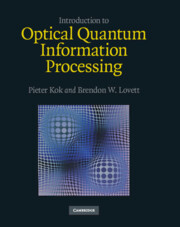Book contents
- Frontmatter
- Dedication
- Contents
- Preface
- Part I Quantum optics and quantum information
- Part II Quantum information in photons and atoms
- 4 Photon sources and detectors
- 5 Quantum communication with single photons
- 6 Quantum computation with single photons
- 7 Atomic quantum information carriers
- Part III Quantum information in many-body systems
- Appendix A Baker–Campbell–Haussdorff relations
- Appendix B The Knill–Laflamme–Milburn protocol
- Appendix C Cross–Kerr nonlinearities for single photons
- References
- Index
5 - Quantum communication with single photons
from Part II - Quantum information in photons and atoms
Published online by Cambridge University Press: 05 July 2014
- Frontmatter
- Dedication
- Contents
- Preface
- Part I Quantum optics and quantum information
- Part II Quantum information in photons and atoms
- 4 Photon sources and detectors
- 5 Quantum communication with single photons
- 6 Quantum computation with single photons
- 7 Atomic quantum information carriers
- Part III Quantum information in many-body systems
- Appendix A Baker–Campbell–Haussdorff relations
- Appendix B The Knill–Laflamme–Milburn protocol
- Appendix C Cross–Kerr nonlinearities for single photons
- References
- Index
Summary
After the preceding four introductory chapters, we are finally ready to discuss optical quantum information processing. While in principle quantum communication can be implemented with atoms or electrons, in practice the implementation of choice for long-distance quantum communication will almost certainly be optical. In this chapter, we will develop some of the key topics in quantum communication with single photons, and we will discuss continuous-variable quantum communication in Chapter 8. In some ways, quantum communication is the most technologically advanced part of quantum information processing. Most protocols in this chapter, such as teleportation and cryptography, have been convincingly demonstrated in the lab, and there are already several commercial organizations that sell cryptographic systems based on quantum mechanical principles. In particular, the promise of secure communication with quantum cryptography is one of the driving forces behind the development of single-photon sources and detectors. In this chapter, we first construct several optical representations of the qubit, including polarized photons and time-bin encoding. Since the single-photon implementation of a qubit is central to optical quantum information processing, this constitutes a large part of the chapter. In Section 5.2 we discuss quantum teleportation and entanglement swapping with single photons. We also present a method for entanglement distillation using entanglement swapping. In Section 5.3 we introduce decoherence-free subspaces, which can be used to reduce noise in the transmission of quantum information, and even establish communication channels in the absence of shared reference frames.
- Type
- Chapter
- Information
- Introduction to Optical Quantum Information Processing , pp. 145 - 178Publisher: Cambridge University PressPrint publication year: 2010



